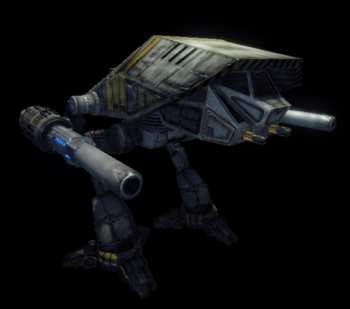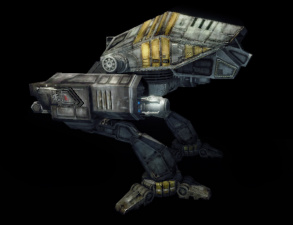Difference between revisions of "Puma"
m (Forgot to change the price of the G variant.) |
Bird Thing (talk | contribs) m |
||
| Line 134: | Line 134: | ||
--> | --> | ||
}} | }} | ||
| − | <!-- Current for 0. | + | <!-- Current for 0.9.1 --> |
The '''Puma''' is a [[Clan]] [[Light Mech]]. All Puma variants lack [[Jump Jets]] and carry a [[Flamer]], while some equip [[MASC]] giving them overall respectable maneuverability. Most Pumas are also equipped with [[GECM]], allowing them to reduce the range at which they can be detected on [[Radar]]. Pumas do have relatively weak [[Armor|Rear Torso Armor]], so care must be applied to protect this one major weak point. | The '''Puma''' is a [[Clan]] [[Light Mech]]. All Puma variants lack [[Jump Jets]] and carry a [[Flamer]], while some equip [[MASC]] giving them overall respectable maneuverability. Most Pumas are also equipped with [[GECM]], allowing them to reduce the range at which they can be detected on [[Radar]]. Pumas do have relatively weak [[Armor|Rear Torso Armor]], so care must be applied to protect this one major weak point. | ||
Revision as of 19:38, 22 January 2018
| Puma | ||
|---|---|---|
| Class: | Light Mech | |
| Faction: | Clan | |
| Ticket cost: | 5 upon destruction | |
| Tier: | 3 | |
| Speed: | 97.2 km/h (136 km/h with MASC) | |
| Torso yaw: | 180° | |
| Torso pitch: | -35° to +55° while standing -35° to +64° while crouching | |
| Variant Armament | ||
| Variant | Weapons | Equipment |
| Prime: Price: 64 500 CBills Total armor: 36 276 Engine Size: |
||
| A: Price: 49 750 CBills Total armor: 34 335 Engine Size: |
||
| B: Price: 57 750 CBills Total armor: 34 335 Engine Size: |
||
| C: Price: 56 250 CBills Total armor: 34 335 Engine Size: |
||
| D: Price: 59 350 CBills Total armor: 40 152 Engine Size: |
||
| E: Price: 57 350 CBills Total armor: 34 335 Engine Size: |
|
|
| F: Price: 51 850 CBills Total armor: 34 335 Engine Size: |
||
| G: Price: 48 500 CBills Total armor: 34 335 Engine Size: |
||
All stats current as of release 0.15.3
The Puma is a Clan Light Mech. All Puma variants lack Jump Jets and carry a Flamer, while some equip MASC giving them overall respectable maneuverability. Most Pumas are also equipped with GECM, allowing them to reduce the range at which they can be detected on Radar. Pumas do have relatively weak Rear Torso Armor, so care must be applied to protect this one major weak point.
Contents
Roles and Gameplay Hints
Prime
Like most Primes this is the most flexible design of the bunch due to its CERPPCs. Though prone to heat complications, chain fire should allow two and a half rounds of fire as soon as they are available. Close and long range fighting are both options due to the Window of Engagement being so short and splash damage very high. To take advantage of its strengths, hit and run tactics and a wide Staggered Approach with Eoptics are recommended to minimize danger of return fire. Also, using flamers to finish off heavily damaged hostiles rather than a CERPPC shot will save heat. When facing this variant, use smaller, faster assets and close range quickly in an Angled Approach, then engage in a circle lock and wait for it to overheat and break off, then follow behind him keeping out of his poor torso turn. Heavier assets should keep in cover and fire on the the Puma from range before it has its own chance to fire.
Variant A
This variant is a slight tweak of the Puma Prime, with one CERPPC and the GECM swapped out for a CUAC10 plus one ton of free space at a significantly reduced c-bill cost in comparison. Heat is much easier to control in the Puma A, making it a more viable Mech on hotter maps, while reducing its vulnerability to Flamer attack. The A is weaker at extreme ranges without the second ERPPC and the Ultra AC10 has a longer travel time, making it more challenging to land shots at range. Like all Pumas, the centre torso Flamer makes short work of any Battle Armor foolish enough to attack it from the front.
Variant B
Where the Puma Prime and A use CERPPCs to dish out damage at range, the Puma B focuses on precision targeting at range with three CERLBLs, all while still being cheaper than the Prime. This setup turns the B into a well-rounded sniper, effective against Mechs, tanks and even aerospace assets. Like the Puma Prime, heat can be a problem, one which can be overcome by using chainfire. The B also retains GECM and is well-protected from BA attack thanks to the Flamer.
Variant C
More of a hunter than the others, precision is needed as if you miss with even part of the beam, you will be punished with a heat spike and chain firing the lasers can lead to a long Window of Engagement and put you at risk. However, an alpha strike with the 6 CERMBL's focuses a total of 2178 energy damage on point, capable of destroying most lightly-armored opponents or disabling crucial components of heavier assets in 2 or 3 well-aimed shots. A Flanking Approach at long range hidden by your GECM may allow you to destroy crucial components on much heavier assets before they realize you are there. Both when using and fighting against this Puma, keep in mind extremely close range can make it difficult to hit with the lasers.
Variant D
Close Range Assault Puma (C.R.A.P.), named so in 0.5.0, is the knife fighter of the bunch, the D has extremely high pin point damage and excellent heat management even with liberal use of MASC. However, the majority of its weapons only work to a dangerous 200m. To complicate things further, the Window of Engagement is extremely long forcing you to face your enemy at close range for long periods of time. As the Puma is a very wide, lightly armored chassis, this is a worst case scenario and this variant is a high risk high reward asset. It is best used to chase and destroy lightly armed assets in a fast Direct Approach where return fire is minimal. If caught by a larger asset, crippling it may be the only option as the Puma is not a great runner if having to run from a 200m engagement. If you are caught in close range by this Puma, quick swinging of the torso will spread the damage of the Heavy Lasers. Never look directly into this Puma's eyes for too long.
Variant E
Best used at short range, the E has more flexibility than the other Pumas due to its MASC, the radar cover of its GECM and the homing of its ATM12s, loaded with HE ammunition. A threat to both lights and heavies if given enough time, pilots should be aware of the long dead time between missile volleys making swift decisions on staying to maximise their DPS or jumping behind cover to give their launcher time to reload. This is best used as a close-range fire support unit or to surprise and smash other light Mechs with deadly barrages of ATMs. The quad CERSBLs are excellent for following up on an ATM strike; with a good pilot at the controls, the E can easily punch above its weight.
Variant F
Similar to a Cougar C at first glance, sporting a cERMBL, a cERLBL, two missile racks and a cNARC launcher, the Puma F plays the role of spotter quite differently. The switch from cLRMs to ATMs as well as the single point defence Flamer standard to all Pumas took a toll tonnage wise, and as a result the variant carries no electronics or equipment to assist it in spotting or approaching its targets. Loading one launcher with fast locking Standard ammunition and another with deadly at close range High Explosive, while carrying more armour as a chassis, the Puma F is more of a skirmisher with the ability to designate targets than a spotter that then takes advantage of its own targeting beacons. Its two main downfalls are its complete inability to afford any tonnage for extra ammo, necessitating careful target prioritisation as a spotter, as well as the very small sweet spot between the 300m range of its HE ATMs and the 120m minimum range of its Std launcher where it can fire all of its weapons. It is only equipped with a single extra DHS, but it isn't a heat intensive variant nor designed for prolonged engagements.
Variant G
The Puma G is a flamer boat on steroids. Sporting an impressive array of eight(!) Flamers, this Puma is made for overheating enemy Mechs into self-destruction. In fact, with that number of flamers it's possible for players to effectively chain or group fire their flamers so that some of them cool down while the rest still effectively overheat their victims with a non-stop stream of flames. Since forcing an enemy Mech into blowing themselves up gives the Puma G's pilot little c-bills for the effort, a pair of UAC5s provides respectable enough firepower for the pilot to chip into the damage dealt pool and reap some of the kill money, or just lay down some suppressing fire while the enemy is outside arm's rach. The cheapest Puma, just a moderate donation outside of starting money, it's a good choice for an early game flamer boat with reliable backup weapons for the times when it can't charge into the extreme short range required to burn up the enemy. The main downside of the Puma G is that while a light mech, it's one of the slowest ones and it doesn't have any mobility enhancing or radar masking equipment to make its approach easier. A trio of DHS is enough insurance that pilots will overheat their opponents way before they overheat themselves.
Gallery
Canon
The Adder, nicknamed by Inner Sphere forces as the Puma, is a light and fast OmniMech which was designed to emulate the weapons configurations commonly seen on IS medium 'Mechs. As a result, it carries a far more potent load of firepower than its tonnage might suggest. Originally designed by Clan Star Adder in preparation for the invasion of the Inner Sphere, the Clan was not able to retain exclusive rights to the design, and by 3045 it had become a common design throughout the Clan military. Used primarily as a fire support unit, the Adder/Puma devotes nearly half its tonnage to modular weaponry, providing easy modification for a variety of roles. The prime configuration, marrying twin ERPPCs with the finesse of an advanced targeting computer, is deadly at almost any range, but has issues with overheating.
BattleTech Reference

